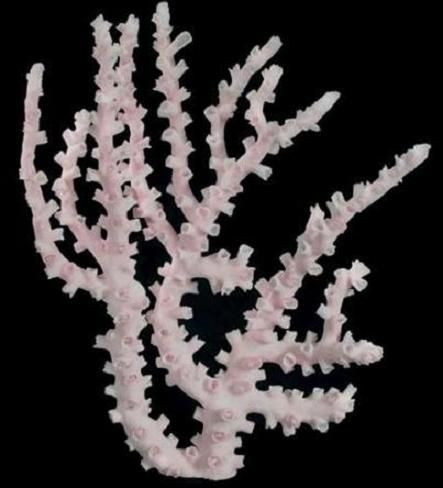Octopus Coral cluster measuring 15 to 18 inches OUT OF STOCK *****
One Octopus Coral cluster measuring 15 to 18 inches.
Orders usually process within 2 to 5 business days.
Email us at ja1@mindspring.com Make Your Selections and Shipping Preference. We Will Email You the amount of the Shipping Cost. When you receive the shipping cost go back into Shells of Aquarius and click into Purchase Shipping Label. There you will find UPS or USPS. Click into the option you decided on and make your payment. Your order will ship when shipping payment is received.
These are a species of colonial stony coral in the family Euphylliidae, commonly known as Octopus coral, Fluorescence grass coral, and Galaxy coral among various vernacular names.
Small colonies of Galaxea fascicularis often form low domes but as they grow, the colonies become more irregular, massively hummocky or columnar and may eventually reach 16 feet across. The corals are the calcareous skeletons of polyps and the variability in shape is at least partly caused by the activities of horse mussels which bore into the skeletons. The individual polyps are embedded in circular, tube-shaped corallites less than 1/2 inch across, made of a limy material extruded by the polyps. Lining the corallites are a large number of ridge-like septa radiating from the center. The polyps often feed in the daytime, and when their tentacles are extended the basic skeleton of the coral is hidden. The general color of the coral ranges from green and grey to reddish brown. The tentacles are often a contrasting color and are usually tipped with white. A few of the tentacles are modified into sweeper tentacles which can be extended to 12 inches in length and serve to deter other organisms from settling close by.
The size and proximity of the corallites varies depending on the amount of light incident on the coral, even over different areas of the same colony. In bright positions, small, closely packed corallites maximize the photosynthetic potential of the zooxanthellae. In less well lit positions, there are larger corallites and polyps with longer tentacles with greater food capturing ability.
Galaxea fascicularis are found in the Red Sea, the Gulf of Aden and in large areas of the Indo-Pacific. They dwell on coral reef slopes, particularly where the wave action is weak. Its depth range is between 6 to 49 feet.
Galaxea fascicularis gets its food from two sources. The polyps contain symbiotic photosynthetic microalgae called zooxanthellae which, under good conditions, can obtain almost sufficient energy from sunlight for the coral's needs. It is also heterotrophic; the polyps extend their tentacles and catch and ingest organic particles, sediment, zooplankton, bacteria and even dissolved organic matter. This supplies the rest of the coral's needs.
Galaxea fascicularis can reproduce asexually by budding. They also reproduces sexually, with both sperm and eggs being released into the water table in synchronized spawning for external fertilization. The planula larvae that develop from the eggs drift as part of the zooplankton. After heavy attrition by predation, the few that survive settle on the seabed, undergo metamorphosis and develop into a polyp. This starts extruding a skeleton, budding and growing into a new colony.
In common with other corals that contain zooxanthella, Galaxea fascicularis are likely to be stressed by climate change and the warmer waters it may cause. Adverse effects of a rise in sea temperature may be more severe storms, a greater incidence of the El Niño-Southern Oscillation and more frequent outbreaks of coral disease. Higher water temperatures tend to kill the symbiotic microalgae causing bleaching of the coral. Without their symbionts, the coral fails to thrive and the polyps may die. Compared to some other reef corals, this species is relatively resistant to bleaching and to being buried by increased sedimentation.
symbionts an individual living in symbiosis especially : the smaller member of a symbiotic pair
symbiosis refers to interaction between two different organisms living in close physical association, typically to the advantage of both.
Galaxea fascicularis are a common species that takes about 8 years to reach maturity, making it difficult to assess its survival status except over long time scales. They are popular in the aquarium trade. In 2005, Indonesia exported 17,550 live pieces and Fiji and other countries exported lesser amounts. Other threats to this species include trawling and consequent reef destruction, pollution and tourism.
Octopus coral are widely available for use in reef aquaria. They have a fragile skeleton and should be handled carefully. The temperature in the tank needs to be maintained between 74° and 81 °F. The coral needs to be in a well lit area with a low or moderate water flow. They should not be placed within 12 inches of any other coral or sessile invertebrate because they use its sweeper tentacles to sting intruders and defend their territory. Cultivated corals can be propagated by sawing the skeleton into lengths and suspending the pieces on threads.
Scientific classification
Domain: Eukaryota
Kingdom: Animalia
Phylum: Cnidaria
Class: Hexacorallia
Order: Scleractinia
Family: Euphylliidae
Genus: Galaxea
Species: Galaxea fascicularis
Binomial name: Galaxea fascicularis
(Linnaeus, 1767)
(REF: Galaxea fascicularis IUCN 2011. IUCN Red List of Threatened Species)(REF: WoRMS (2010). "Galaxea fascicularis (Linnaeus, 1767)". WoRMS. World Register of Marine Species.)(REF: Galaxy coral Animal-World. Retrieved 2011)(REF: Galaxea fascicularis Corals of the World online. Retrieved 2011)(REF: Crabbe, M. James C.; David J. Smith (2006). "Modelling variations in corallite morphology of Galaxea fascicularis coral colonies with depth and light on coastal fringing reefs in the Wakatobi Marine National Park (S.E. Sulawesi, Indonesia)" (PDF). Computational Biology and Chemistry. 30 (2): 155–159. doi:10.1016/j.compbiolchem.2005)(REF: Fluorescence grass coral (Galaxea fascicularis) Archived 2011-12-11 at the Wayback Machine ARKive. Retrieved 2011)(REF: Marshall, P.A., Baird, A.H., 2000. Bleaching of corals on the Great Barrier Reef: differential susceptibilities among taxa. Coral Reefs 19)(REF: Philipp, E., Fabricius, K., 2003. Photophysiological stress in scleractinian corals in response to short-term sedimentation. J. Exp. Mar. Biol. Ecol. 287)
